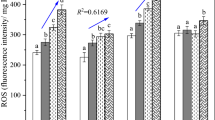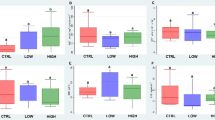Abstract
Biochemical effects of tetrabromobisphenol A (TBBPA) on the earthworm Eisenia fetida, including superoxide dismutase, catalase, glutathione-S-transferase, reduced glutathione, oxidized glutathione, GSH/GSSG ratio and malondialdehyde (MDA) level, were measured to assess ecological toxicity of TBBPA. With OECD standard filter-paper contact test method, earthworms were exposed to TBBPA of a range of concentrations (0.00, 0.01, 0.05, 0.1, 0.5 and 1.0 mg L−1). According to the electron paramagnetic resonance spectrum, reactive oxygen species (ROS) generated in the earthworm was identified as the hydroxyl radical (•OH) which was significantly induced at all TBBPA concentrations. With the increasing of TBBPA concentration, the antioxidant enzymes, glutathione and MDA levels varied significantly. The results showed that TBBPA exerts its toxic effects on E. fetida by inducing the generation of ROS and resulting in oxidative damage. The results show that the •OH production leads to oxidative stress in the tissues of the earthworm E. fetida.


Similar content being viewed by others
References
Alaee M, Arias P, Sjodin A (2003) An overview of commercially used brominated flame retardants, their applications, their use patterns in different countries/regions and possible modes of release. Environ Int 29:683–689. doi:10.1016/S0160-4120(03)00121-1
Arnaud C, Saint-Denis M, Narbonne JF (2000) Influences of different standardised test methods on biochemical responses in the earthworm Eisenia fetida andrei. Soil Biol Biochem 32:67–73. doi:10.1016/S0038-0717(99)00130-3
Arnon S, Ronen Z, Yakirevich A (2006) Evaluation of soil flushing potential for clean-up of desert soil contaminated by industrial wastewater. Chemosphere 62:17–25. doi:10.1016/j.chemosphere.2005.04.050
Arts MSJ, Schill RO, Knigge T, Eckwert H, Kammenga JE, KÖhler HR (2004) Stress proteins (hsp70, hsp60) induced in isopods and nematodes by field exposure to metals in a gradient near Avonmouth, UK. Ecotoxicology 13:739–755. doi:10.1007/s10646-003-4473-5
Bradford MM (1976) A rapid and sensitive method for the quantitation of microgram quantities of protein utilizing the principle of protein dye binding. Anal Biochem 72:248–254. doi:10.1016/0003-2697(76)90527-3
BSEF (2008) Bromine science and environmental forum (BSEF). Available at http://www.bsef.com
Bundy JG, Spurgeon DJ, Svendsen C, Hankard PK, Weeks JM, Osborn D, Lindon JC, Nicholson JK (2004) Environmental metabonomics: applying combination biomarker analysis in earthworms at a metal contaminated site. Ecotoxicology 13:797–806. doi:10.1007/s10646-003-4477-1
Cheung CCC, Zheng GJ, Li AMY (2001) Relationships between tissue concentrations of polycyclic aromatic hydrocarbons and antioxidative responses of marine mussels, Perna viridis. Aquat Toxicol 52:189–203. doi:10.1016/S0166-445X(00)00145-4
Darnerud PO (2003) Toxic effects of brominated flame retardants in man and in wildlife. Environ Int 29:841–853. doi:10.1016/S0160-4120(03)00107-7
de Wit CA (2002) An overview of brominated flame retardants in the environment. Chemosphere 46:583–624. doi:10.1016/S0045-6535(01)00225-9
de Wit CA, Alaee M, Muir DCG (2006) Levels and trends of brominated flame retardants in the Arctic. Chemosphere 64:209–233. doi:10.1016/j.chemosphere.2005.12.029
Dhindsa RS, Dhinsa PP, Thorpe TA (1980) Leaf senescence: correlated with increased levels of membrane permeability and lipidperoxidation and decreased levels of superoxide dismutase and catalase. J Exp Bot 32:127–132
Goats GC, Edwards CA (1988) The prediction of field toxicity of chemicals to earthworms by laboratory methods. In: Edwards CA, Neuhauser EF (eds) Earthworms in waste and environmental assessment. SPB Academic Publishing, The Hague, pp 283–294
Gonzalez Flecha BS, Repetto M, Evelson P (1991) Inhibition of microsomal lipid peroxidation by alphatocopherol and alpha-tocopherol acetate. Xenobiotica 21:1013–1022
Habig WH, Pabst MJ, Jakoby WB (1974) Glutathione S-transferases: the first enzymatic step in mercapturic acid formation. J Biol Chem 249:7130–7139
Halliwell B, Gutteridge JMC (1999) Antioxidant defences. In: Free radicals in biology and medicine, 3rd edn. Oxford University Press Inc, Oxford, pp 105–245
Hissin PJ, Hilf R (1976) A fluorometric method for the direct determination of oxidized and reduced glutathione in tissues. Anal Biochem 74:214–226. doi:10.1016/0003-2697(76)90326-2
ISO (1998) Standard number No. 11268-2. Soil quality: effects of pollutants on earthworms (Eisenia fetida). Part II. Method for the determination of effects on reproduction. International Standard Organization, Geneva
Kammenga JE, Weeks JM (2004) Editorial. Ecotoxicology 13:723–724. doi:10.1007/s10646-004-4471-2
Lange A, Ausseil O, Segner H (2002) Alterations of tissue glutathione levels and metallothionein mRNA in rainbow trout during single and combined exposure to cadmium and zinc. Comp Biochem Phys C 131:231–243
Li YN, Zhou QX, Li FX, Liu XL, Luo Y (2008) Effects of tetrabromobisphenol A as an emerging pollutant on wheat (Triticum aestivum) at biochemical levels. Chemosphere 74:119–224. doi:10.1016/j.chemosphere.2008.08.024
Luo Y, Wang XR, Shi HH (2005) Electron paramagnetic resonance investigation of in vivo free radical formation and oxidative stress induced by 2, 4-dichlorophenol in the freshwater fish Carassius auratus. Environ Toxicol Chem 24:2145–2153. doi:10.1897/04-640R.1
Mariussen E, Fonnum F (2003) The effect of brominated flame retardants on neurotransmitter uptake into rat brain synaptosomes and vesicles. Neurochem Int 43:533–542. doi:10.1016/S0197-0186(03)00044-5
Miller DM, Aust SD (1989) Studies of ascorbate-dependent, iron catalyzed lipid peroxidation. Arch Biochem Biophys 271:113–119. doi:10.1016/0003-9861(89)90261-0
Morris S, Allchin CR, Zegers BN, Haftka JJ, Boon JP, Belpaire C, Leonards PE, Van Leeuwen SP, De Boer J (2004) Distribution and fate of HBCD and TBBPA brominated flame retardants in North Sea estuaries and aquatic food webs. Environ Sci Technol 38:5497–5504. doi:10.1021/es049640i
Oberg K, Warman K, Oberg T (2002) Distribution and levels of brominated flame retardants in sewage sludge. Chemosphere 48:805–809. doi:10.1016/S0045-6535(02)00113-3
OECD (1984) Test 207: earthworm, acute toxicity tests. In: Organization for Economic Co-operation and Development (ed), OECD Guidelines for Testing of Chemicals, Paris
Reistad T, Mariussen E, Ring A (2007) In vitro toxicity of tetrabromobisphenol-A on cerebellar granule cells: cell death, free radical formation, calcium influx and extracellular glutamate. Toxicol Sci 96:268–278. doi:10.1093/toxsci/kfl198
Ribera D, Narbonne JF, Arnaud C (2001) Biochemical responses of the earthworm Eisenia fetida andrei exposed to contaminated artificial soil, effects of carbaryl. Soil Biol Biochem 33:1123–1130. doi:10.1016/S0038-0717(01)00035-9
Ronisz D, Finne EF, Karlsson H (2004) Effects of the brominated flame retardants hexabromocyclododecane (HBCDD), and tetrabromobisphenol A (TBBPA), on hepatic enzymes and other biomarkers in juvenile rainbow trout and feral eelpout. Aquat Toxicol 69:229–245. doi:10.1016/j.aquatox.2004.05.007
Saint-Denis M, Narbonne JF, Arnaud C (1999) Biochemical responses of the earthworm Eisenia fetida andrei exposed to contaminated artificial soil: effects of benzo(a)pyrene. Soil Biol Biochem 31:1837–1846. doi:10.1016/S0038-0717(99)00106-6
Saint-Denis M, Narbonne JF, Arnaud C (2001) Biochemical responses of the earthworm Eisenia fetida andrei exposed to contaminated artificial soil: effects of lead acetate. Soil Biol Biochem 33:395–404. doi:10.1016/S0038-0717(00)00177-2
Sanchez-Hernandez JC (2006) Earthworm biomarkers in ecological risk assess. Rev Environ Contam Toxicol 188:85–126. doi:10.1007/978-0-387-32964-2_3
Sellström U, Jansson B (1995) Analysis of tetrabromobisphenol A in a product and environmental samples. Chemosphere 31:3085–3092. doi:10.1016/0045-6535(95)00167-7
Shalata A, Tal M (1998) The effect of salt stress on lipid peroxidation and antioxidants in the leaf of the cultivated tomato and its wild salttolerant relative Lycopersicon pennellii. Physiol Plant 104:169–174. doi:10.1034/j.1399-3054.1998.1040204.x
Shi HH, Wang XR, Luo Y (2005a) Electron paramagnetic resonance evidence of hydroxyl radical generation and oxidative damage induced by tetrabromobisphenol A in Carassius auratus. Aquat Toxicol 74:365–371. doi:10.1016/j.aquatox.2005.06.009
Shi HH, Sui YX, Wang XR (2005b) Hydroxyl radical production and oxidative damage induced by cadmium and naphthalene in liver of Carassius auratus. Comp Biochem Phys C 140:115–121
Simonsen V, Scott-Fordsmand JJ (2004) Genetic variation in the enzyme esterase, bioaccumulation and life history traits in the earthworm Lumbricus Rubellus from a metal contaminated area, Avonmouth, England. Ecotoxicology 13:773–786. doi:10.1007/s10646-003-4475-3
Spurgeon DJ, Ricketts H, Svendsen C, Morgan AJ, Kille P (2005) Hierarchical responses of soil invertebrates (earthworms) to toxic metal stress. Environ Sci Technol 39:5327–5334. doi:10.1021/es050033k
Sulata M, Sonali R, Shibani C, Shelley B (2004) Antioxidant responses of the earthworm Lampito mauritii exposed to Pb and Zn contaminated soil. Environ Pollut 151:1–7
Sun YY, Yu HX, Zhang JF (2006) Bioaccumulation, depuration and oxidative stress in fish Carassius auratus under phenanthrene exposure. Chemosphere 63:1319–1327. doi:10.1016/j.chemosphere.2005.09.032
Sun YY, Yin Y, Zhang JF (2007) Bioaccumulation and ROS generation in liver of freshwater fish, goldfish Carassius auratus under HC Orange No. 1 exposure. Environ Toxicol 22:256–263. doi:10.1002/tox.20262
Sun YY, Guo HY, Yu HX (2008) Bioaccumulation and physiological effects of tetrabromobisphenol A in coontail Ceratophyllum demersum L. Chemosphere 70:1787–1795. doi:10.1016/j.chemosphere.2007.08.033
Szymanska JA, Piotrowski JK, Frydrych B (2000) Hepatotoxicity of tetrabromobisphenol-A: effects of repeated dosage in rats. Toxicology 142:87–95. doi:10.1016/S0300-483X(99)00108-0
Takeshita K, Fujii K, Anzai K (2004) In vivo monitoring of hydroxyl radical generation caused by X-ray irradiation of rats using the spin trapping/EPR technique. Free Radic Biol Med 36:1134–1143. doi:10.1016/j.freeradbiomed.2004.02.016
Watanabe I, Kashimoto T, Tatsukawa R (1983) The flame retardant tetrabromobisphenol-A and its metabolite found in river and marine sediments in Japan. Chemosphere 12:1533–1539. doi:10.1016/0045-6535(83)90084-X
Weeks JM, Spurgeon DJ, Svendsen C, Hankard PK, Kammenga JE, Dallinger R, Köhler HR, Simonsen V, Scott-Fordsmand JJ (2004) Critical analysis of soil invertebrate biomarkers: a field case study in Avonmouth, UK. Ecotoxicology 13:817–822. doi:10.1007/s10646-003-4479-z
Xu JB, Yuan XF, Lang PZ (1997) Determination of catalase activity and catalase inhibition by ultraviolet spectrophotometry. Chin Environ Chem 16:73–76
Yin Y, Jia HX, Sun YY (2007) Bioaccumulation and ROS generation in liver of Carassius auratus, exposed to phenanthrene. Comp Biochem Phys C 145:288–293
Acknowledgments
This study was funded by the National Natural Science Foundation of China (20577021) and State Key Laboratory of Pollution Control and Resource Reuse (Tongji University, PR China, PCRRF07007). The authors wish to thank Yunxia Sui for her technical help with analysis of EPR spectra. The authors also wish to thank Professors Shupei Cheng and Lee Shugart for their kind help.
Author information
Authors and Affiliations
Corresponding author
Rights and permissions
About this article
Cite this article
Xue, Y., Gu, X., Wang, X. et al. The hydroxyl radical generation and oxidative stress for the earthworm Eisenia fetida exposed to tetrabromobisphenol A. Ecotoxicology 18, 693–699 (2009). https://doi.org/10.1007/s10646-009-0333-2
Received:
Accepted:
Published:
Issue Date:
DOI: https://doi.org/10.1007/s10646-009-0333-2




